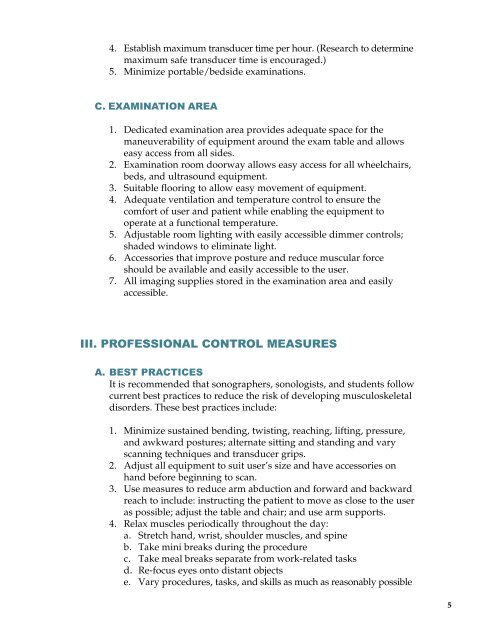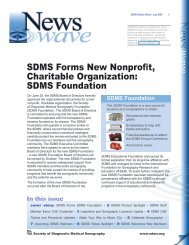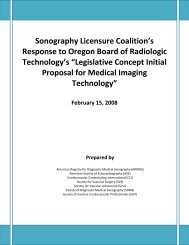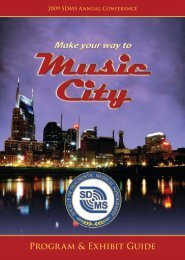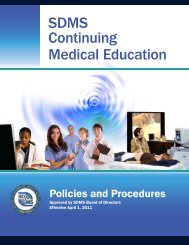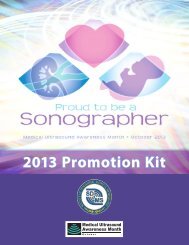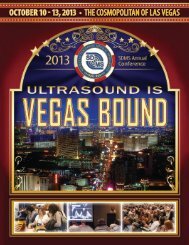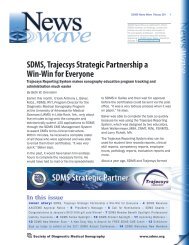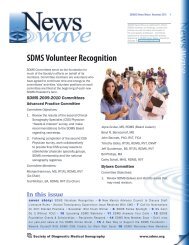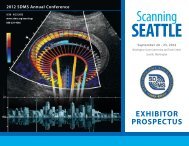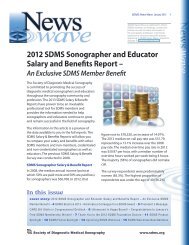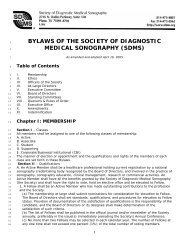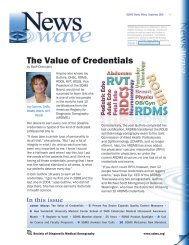Industry Standards - Society of Diagnostic Medical Sonography
Industry Standards - Society of Diagnostic Medical Sonography
Industry Standards - Society of Diagnostic Medical Sonography
You also want an ePaper? Increase the reach of your titles
YUMPU automatically turns print PDFs into web optimized ePapers that Google loves.
4. Establish maximum transducer time per hour. (Research to determine<br />
maximum safe transducer time is encouraged.)<br />
5. Minimize portable/bedside examinations.<br />
C. EXAMINATION AREA<br />
1. Dedicated examination area provides adequate space for the<br />
maneuverability <strong>of</strong> equipment around the exam table and allows<br />
easy access from all sides.<br />
2. Examination room doorway allows easy access for all wheelchairs,<br />
beds, and ultrasound equipment.<br />
3. Suitable flooring to allow easy movement <strong>of</strong> equipment.<br />
4. Adequate ventilation and temperature control to ensure the<br />
comfort <strong>of</strong> user and patient while enabling the equipment to<br />
operate at a functional temperature.<br />
5. Adjustable room lighting with easily accessible dimmer controls;<br />
shaded windows to eliminate light.<br />
6. Accessories that improve posture and reduce muscular force<br />
should be available and easily accessible to the user.<br />
7. All imaging supplies stored in the examination area and easily<br />
accessible.<br />
III. PROFESSIONAL CONTROL MEASURES<br />
A. BEST PRACTICES<br />
It is recommended that sonographers, sonologists, and students follow<br />
current best practices to reduce the risk <strong>of</strong> developing musculoskeletal<br />
disorders. These best practices include:<br />
1. Minimize sustained bending, twisting, reaching, lifting, pressure,<br />
and awkward postures; alternate sitting and standing and vary<br />
scanning techniques and transducer grips.<br />
2. Adjust all equipment to suit user’s size and have accessories on<br />
hand before beginning to scan.<br />
3. Use measures to reduce arm abduction and forward and backward<br />
reach to include: instructing the patient to move as close to the user<br />
as possible; adjust the table and chair; and use arm supports.<br />
4. Relax muscles periodically throughout the day:<br />
a. Stretch hand, wrist, shoulder muscles, and spine<br />
b. Take mini breaks during the procedure<br />
c. Take meal breaks separate from work-related tasks<br />
d. Re-focus eyes onto distant objects<br />
e. Vary procedures, tasks, and skills as much as reasonably possible<br />
5


